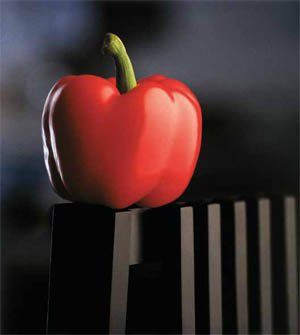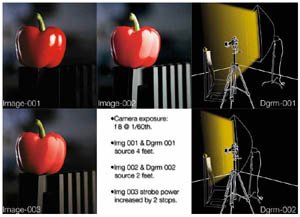articles/Lighting/bigred-page1
Big Red - part 1 of 1 2
by Dave Montizambert Published 01/12/2012

Image 001: A 3x4 foot Chimera soft-box fitted with a Whitelightning mono-block studio strobe is placed to the camera right side of the red pepper at a distance of four feet. The brightness of this light is set to f 8 to match the camera exposure setting for a correct exposure of the red pepper.
Now on to the subject of this article, Big Red. When speaking of light quality we often say, the light is soft or the light is hard. How soft or hard the light appears to us is governed by how pronounced the edges of shadows appear as well as how much brighter specular highlights (reflections of light sources imaged on the subject) are than the actual tone of the subject they sit on. Since we looked at shadows last time, let's look at how to control the brightness of specular highlights for this article. Not all table-top photography has to be done in a studio environment. For someone starting out in photography, creating images of small objects, such as a red pepper, is ideal. A red pepper is a relatively small subject, the whole set placed around it takes up very little space making it possible to shoot inside a small room, in fact the 'Big Red' image was created in a kitchen. The pepper was placed on the top of a designer chair back and was positioned so that the kitchen cabinets behind the pepper could act as a soft-edged background. By working with shallow depth of field, in this case f 8, the cabinets were thrown out of focus. Normally we think of f 8 as being a fair bit of depth of field, which it is on a larger object such as a person, but in close on a small object such as a red pepper, f 8 provides surprisingly little. Keeping backgrounds very 'soft' means that just about anything can act as a background. The red pepper has a somewhat rounded surface, which means that it 'sees' a large area - a large portion of the room around it is reflected on its surface. To create a decent sized specular highlight on the pepper's surface, a relatively large soft-box was used. However, with the 3x4 foot soft-box 4 feet away from the pepper, specular Contrast (brightness of the specular highlight relative to the a correct brightness of the red pepper) was too high, see Image 001. Notice how opaque the specular appears, you cannot see any detail behind it. Since a 'softer' look was wanted, the brightness of the specular highlight relative to the pepper's true brightness was too great. For the prevailing tastes, it needed to be one quarter of its present brightness. Switching to a four times larger light source would drop the brightness of the specular down to one quarter. However, available space and equipment made this an impractical solution.
Skill Testing Question: If you cannot make a light source larger how else can you make it appear four times larger to the subject?
DISTANCE OF LIGHT SOURCE TO SUBJECT - Changing the distance of the light source will affect the brightness of all specular highlights caused by that light. The question is, to reduce the brightness of the specular highlight on the red pepper, would you move the light source further away or closer?

Image 002: The distance of the soft-box main-light to the pepper is halved from 4 feet to 2 feet. • Image 003: The exposure of the main-light is adjusted.
In Image 002 of 'Big Red' the four foot distance of the soft-box to the subject is halved (two feet). Notice how the specular highlight is altered - it appears larger, in fact four times larger, yet it appears the same brightness. How is it possible that the specular highlight can cover a four times larger area and still be the same brightness? Moving the light source closer to the subject, from four feet to two feet, will cause four times more light to fall on the subject. The specular highlight appears to be the same brightness because the amount of light energy increased at the same rate that the specular highlight increased in size on the red pepper. Four times more energy spread over a four times larger area equals same intensity.
They cancel each other out. Look closely at the red pepper, apart from the specular highlight changing in size, what else has changed? The pepper's red tone in Image 002 is overexposed. For a correct representation of the pepper this exposure needs to be adjusted so that the red surface of the pepper appears as it did in Image 001. By turning down the power of the strobe head by two f-stops, or by selecting a smaller aperture opening, f16 (though not an option since shallow depth of field is still needed),
the pepper's red tone will be correctly exposed once again. But what will this adjustment do to the specular brightness? Look at Image 003, the pepper's true tone is correctly exposed and the specular brightness has diminished. You see, both the pepper's true tone and the specular highlight received more light. The subject's true tone becomes brighter while the specular highlight stays the same brightness. The specular stays the same brightness because it becomes larger at the same rate that it receives more light energy. The specular highlight became four times bigger at the same time that it received four times more light, the size increase cancels out the energy increase keeping it the same intensity. Since the pepper's true tone receives more light, it does get brighter. To keep a correct exposure it is necessary to re-meter. The meter provides a reading, instructing us to decrease the exposure. This new exposure brings the brightness of the pepper's red tone back down to a correct exposure.
You are currently on page 1 Contact Dave Montizambert
1st Published 01/12/2012
last update 09/12/2022 14:51:45
More Lighting Articles
There are 16 days to get ready for The Society of Photographers Convention and Trade Show at The Novotel London West, Hammersmith ...
which starts on Wednesday 14th January 2026





